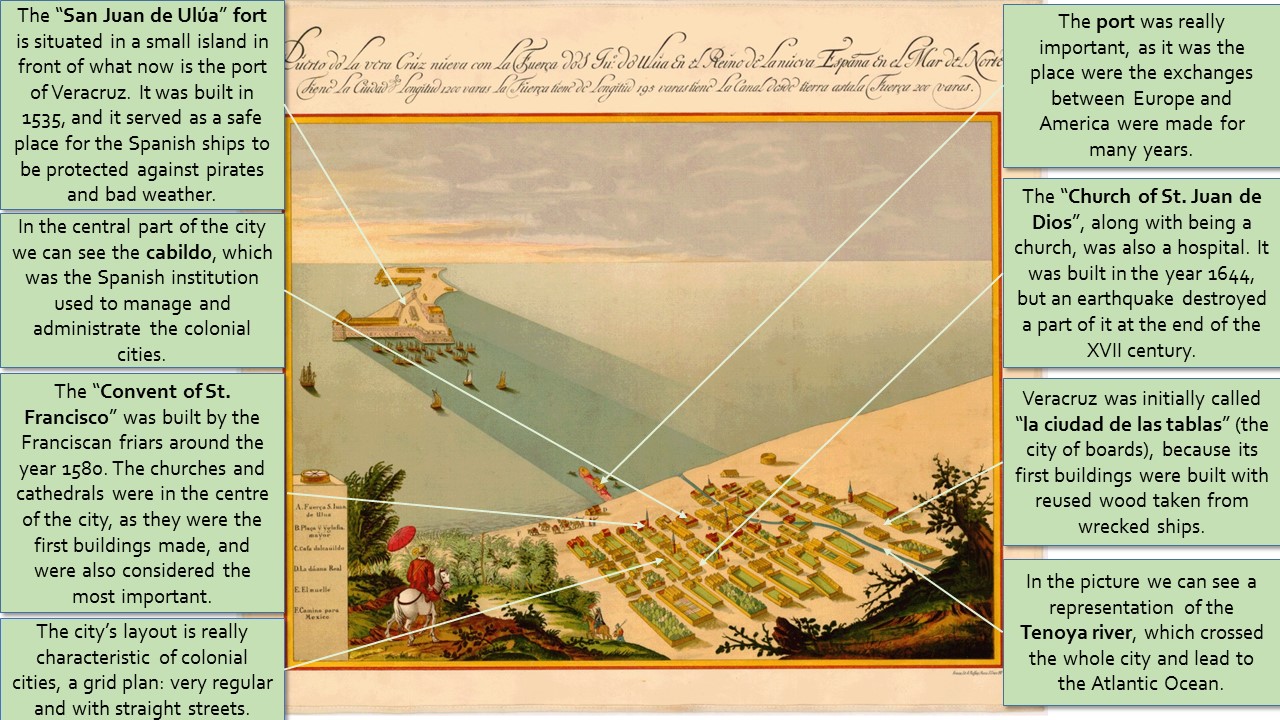This picture is a representation of the city of Veracruz, which is located in the east coast of Mexico, in the state of Veracruz. The author of the original image is unknown, as the image is not signed, although it is thought it could be a German engineer called Adrian Boot. This is because this picture has many similarities and a similar style with another representation of the Mexican city of Acapulco, which is, indeed, signed by A. Boot. This version is a chromolithography made in Florence in the year 1907. The exact date of the original version is also unknown, however, it is thought that it was drawn around the year 1620.
Veracruz is located in the east coast of Mexico, and it was the first city founded by European colonizers in Continental America. It was founded by Hernán Cortés through an expedition that took place in the year 1519. The first name given to the city was “Villa Rica de la Vera Cruz” (Vera Cruz meaning “the holy cross”).
One of the most remarkable elements that can be seen in the picture is the San Juan de Ulúa fort. This fortress was built in a small island next to the Mexican coast (island of San Juan de Ulúa), with the purpose of protecting the Spanish ships from the pirates. This was the first place the Spanish colonizers arrived to, and from here, they went on to the beach of what would be the city of Veracruz.
The city of Veracruz does not count with walls or barriers for protection it in the picture, even though there are documents and drawings that prove the city had defenses around the year 1590. This is because Veracruz was the objective of many attacks, given that it was the starting point of many ships loaded with gold and goods travelling to Spain. The pirate attacks were one of the main problems for the colonizers at the time, as they not only lost many of their goods, but the attacks usually ended up with rapes and assassinations.
Talking about the urban layout, there is a common characteristic every Spanish colonial city in Latin America. That is the grid plan; in other words, the streets are parallels and the buildings make square portions in between the crosses of the streets. Around the main street, which is in the central part, there can be seen the main buildings of the city, which are the churches and the “cabildo” (which can be compared to the current city halls). One remarkable characteristic of the city plan is the position of the port, given that it is far away from the urban part of the city, but with the intention of protecting it against attacks.
The outskirts of the city were destined to cropfields, barns, stockbreeding and other agrarian activities. Given the heavy catholic upbringing of the Spanish kingdom, the churches were one of the most important elements of a colonial city, as they were the symbol of the evangelisation of the land conquered by Spain. One of the most important ones is the convent of St. Francisco de Veracruz, which was built around the year 1580. It had a significant importance in the Veracruz port, as it was the place where the reunions between the sailors and the officers had to be hold.
Another significant building was the “cabildo”. The “cabildos” were the municipal institutions created by the Spanish colonizers to manage the cities. When a city was founded, the founder chose between its officers the most suitable to take the role of “alcalde” and “cabildo”. As it can be seen in the guide of the picture, they called them “casa del cabildo” (house of the cabildo).
The port of the city of Veracruz became, with the time, the opening door for the goods to travel across the Atlantic Ocean and into Europe. It became crucial, not only for Veracruz, but for other Mexican cities like Acapulco, Puebla or Ciudad de México, because it was the place where the exchanges between Europe and Continental America were made. The most significant materials found in Veracruz were gold and minerals, and this is one of the reasons why the city was initially called “Villa Rica de la Vera Cruz”.
Lucía Gómez Muñoz

